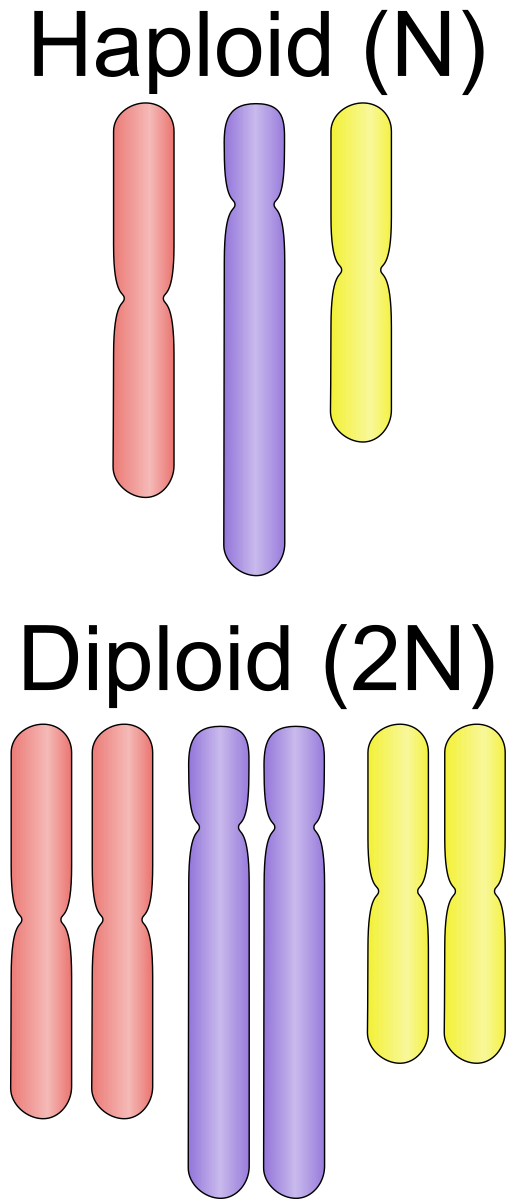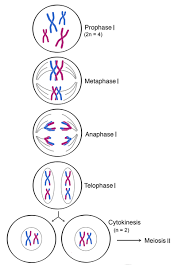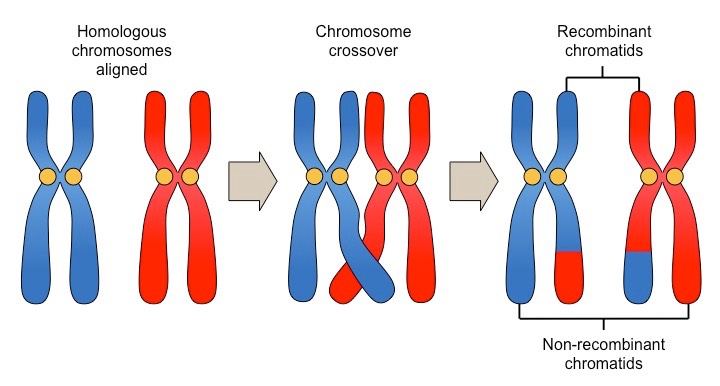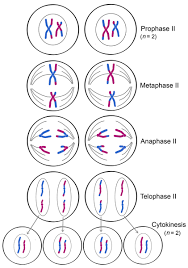Caroline Koffke
Haseung Jun
Caroline Koffke
Haseung Jun
Skills you’ll gain in this topic:
- Describe meiosis stages and compare them to mitosis.
- Explain how meiosis reduces chromosome number and maintains genetic continuity.
- Illustrate how independent assortment and crossing over create genetic diversity.
- Predict chromosome distribution outcomes after meiosis.
- Relate meiosis to patterns of inheritance in sexual reproduction.
How Meiosis Generates Genetic Variation
Meiosis is the process that all organisms go through in order to produce gametes, or sex cells. The process differs from mitosis, the process of somatic cell division, in a number of key ways. Always remember that the purpose of meiosis is to create variation within the population. As you'll see, there are many different mechanisms to create variation in the sex cells. Instead of creating an exact replica of its mother cell, in meiosis, the daughter cells look similar to its parent cells but not quite identical. Meiosis involves one round of DNA replication and two rounds of cellular division. The resulting cells are all genetically unique from one another and from the parent cell. The resulting cells are also haploid, meaning that they have half of the genetic content of a typical somatic cell.
A normal human being has 46 chromosomes, but if a gamete was produced with two diploid cells (meaning each sex cell contained 46 chromosomes), the resulting gamete would have 92 chromosomes! If we even have one extra chromosome, our body doesn't know how to deal with it, so imagine having twice as many chromosomes in your body! 💣💣
This is why during the process of meiosis, each sex cell only contains n amounts of chromosomes, so that the resulting gamete would be 2n, or a diploid cell. In the human's example, the sex cells would have 23 chromosomes each, so that the gamete has 46 chromosomes, which is the normal amount of chromosomes a human ought to have.

Image courtesy of WikiMedia Commons
The diagram below will walk through the steps that take place in meiosis and their importance to the creation of egg and sperm. Meiosis consists of two steps: Meiosis I and Meiosis II. Meiosis I consists of Prophase I, Metaphase I, Anaphase I and Telophase I. As you might guess, Meiosis II consists of Prophase II, Metaphase II, Anaphase II, and Telophase II.
Meiosis I

Image Courtesy of Life Sciences Cyberbridge
Prophase I
Prophase is like regular prophase from mitosis. Like mitosis, DNA replicates and coils into nice chromosomes and the nuclear membrane disappears. But these chromosomes then go on to find their counterparts, or homologous pairs. Homologous pairs are pairs of the chromosomes that contain and code for the same information. These homologous pairs may also cross over, which is sharing information with each other. This creates more variation with the sex cells.

Image Courtesy of BioNinja
Metaphase I
Metaphase I is also like good old metaphase from mitosis. But instead of lining up in the center individually, the chromosomes line up in homologous pairs. For example, chromosomes that contain DNA coding for hair color would line up together as homologous pairs while chromosomes containing information on eye color might line up together. Keep in mind, one of each within the homologous pairs comes from the mother, while the other comes from the father's DNA. 🧬🧬
Also note that alignment is random, so the mother's DNA could end up on the right for one homologous pair, while the father's DNA could end up also on the right for another homologous pair. This also increases variation!
Anaphase I
Each homologous pair is separated and moved to its respective poles, just like in regular anaphase. However, these chromosomes are stay intact, so the chromosomes are not split into chromatids like in anaphase.
Telophase I
Two daughter cells are created with 46 chromosomes! It almost might feel like mitosis because nothing really changed in chromosome numbers but keep in mind! The chromosomes now contain variation, which is the sole purpose of meiosis!
Meiosis II

Image Courtesy of Life Sciences Cyberbridge
Prophase II
New spindles are formed and the chromosomes start coiling.
Metaphase II
The sister chromatids are lined up at the center of the cell.
Anaphase II
The chromatids are pulled apart.
Telophase II
The cell divides into two and voila! Four cells are created with different DNA from all four grandparent cells! This is what you call diversity! Now, the cells have n amount of chromosomes, or 23 chromosomes in each cell.
So basically, long story short, one cell duplicates its DNA, mixes the DNA and separates into normal-number-chromosome cells. Then, it divides once more to have half number of chromosomes in each of the four sex cells. You could then ask, why didn't the cell just divide into half? Well, remember, the whole point of meiosis is diversity, so mixing the DNA in meiosis I is crucial in serving its purpose!
A more simplified version (to understand the whole process) can be seen below!
1️⃣ Step 1
Step 1 shows the replication of DNA, as the cells now have the signature “X” formation of a duplicated chromosome.
2️⃣ Step 2
Step 2 shows homologous chromosomes pairing up. Homologous chromosomes are different versions of the same chromosome. For example, humans have two versions of 23 chromosomes, for a total of 46 chromosomes. During this step of meiosis, our two different versions of our 23 chromosomes would pair up with one another in preparation for division.
3️⃣ Step 3
Step 3 shows the action of crossing over between homologous chromosomes, a process that will be thoroughly discussed in the next section.

Image courtesy of WikiMedia Commons
4️⃣ Step 4
Step 4 shows the first round of cellular division, resulting in the splitting of homologous chromosomes. The chromosomes that remain are referred to as sister chromatids.
5️⃣ Step 5
Step 5 shows the second round of cellular division, resulting in four genetically unique daughter cells. In comparison to the starting cell on the left hand side, the daughter cells have half the amount of chromosomes.
The AP exam does NOT require you to know the specific phases of cellular division (Prophase, Metaphase, Anaphase, and Telophase), so focus your energy on remembering how the chromosomes generally move and how the process contributes to genetic diversity.
Check out the AP Bio Unit 5 Replays or watch the 2021 Unit 5 Cram
<< Hide Menu
Caroline Koffke
Haseung Jun
Caroline Koffke
Haseung Jun
Skills you’ll gain in this topic:
- Describe meiosis stages and compare them to mitosis.
- Explain how meiosis reduces chromosome number and maintains genetic continuity.
- Illustrate how independent assortment and crossing over create genetic diversity.
- Predict chromosome distribution outcomes after meiosis.
- Relate meiosis to patterns of inheritance in sexual reproduction.
How Meiosis Generates Genetic Variation
Meiosis is the process that all organisms go through in order to produce gametes, or sex cells. The process differs from mitosis, the process of somatic cell division, in a number of key ways. Always remember that the purpose of meiosis is to create variation within the population. As you'll see, there are many different mechanisms to create variation in the sex cells. Instead of creating an exact replica of its mother cell, in meiosis, the daughter cells look similar to its parent cells but not quite identical. Meiosis involves one round of DNA replication and two rounds of cellular division. The resulting cells are all genetically unique from one another and from the parent cell. The resulting cells are also haploid, meaning that they have half of the genetic content of a typical somatic cell.
A normal human being has 46 chromosomes, but if a gamete was produced with two diploid cells (meaning each sex cell contained 46 chromosomes), the resulting gamete would have 92 chromosomes! If we even have one extra chromosome, our body doesn't know how to deal with it, so imagine having twice as many chromosomes in your body! 💣💣
This is why during the process of meiosis, each sex cell only contains n amounts of chromosomes, so that the resulting gamete would be 2n, or a diploid cell. In the human's example, the sex cells would have 23 chromosomes each, so that the gamete has 46 chromosomes, which is the normal amount of chromosomes a human ought to have.

Image courtesy of WikiMedia Commons
The diagram below will walk through the steps that take place in meiosis and their importance to the creation of egg and sperm. Meiosis consists of two steps: Meiosis I and Meiosis II. Meiosis I consists of Prophase I, Metaphase I, Anaphase I and Telophase I. As you might guess, Meiosis II consists of Prophase II, Metaphase II, Anaphase II, and Telophase II.
Meiosis I

Image Courtesy of Life Sciences Cyberbridge
Prophase I
Prophase is like regular prophase from mitosis. Like mitosis, DNA replicates and coils into nice chromosomes and the nuclear membrane disappears. But these chromosomes then go on to find their counterparts, or homologous pairs. Homologous pairs are pairs of the chromosomes that contain and code for the same information. These homologous pairs may also cross over, which is sharing information with each other. This creates more variation with the sex cells.

Image Courtesy of BioNinja
Metaphase I
Metaphase I is also like good old metaphase from mitosis. But instead of lining up in the center individually, the chromosomes line up in homologous pairs. For example, chromosomes that contain DNA coding for hair color would line up together as homologous pairs while chromosomes containing information on eye color might line up together. Keep in mind, one of each within the homologous pairs comes from the mother, while the other comes from the father's DNA. 🧬🧬
Also note that alignment is random, so the mother's DNA could end up on the right for one homologous pair, while the father's DNA could end up also on the right for another homologous pair. This also increases variation!
Anaphase I
Each homologous pair is separated and moved to its respective poles, just like in regular anaphase. However, these chromosomes are stay intact, so the chromosomes are not split into chromatids like in anaphase.
Telophase I
Two daughter cells are created with 46 chromosomes! It almost might feel like mitosis because nothing really changed in chromosome numbers but keep in mind! The chromosomes now contain variation, which is the sole purpose of meiosis!
Meiosis II

Image Courtesy of Life Sciences Cyberbridge
Prophase II
New spindles are formed and the chromosomes start coiling.
Metaphase II
The sister chromatids are lined up at the center of the cell.
Anaphase II
The chromatids are pulled apart.
Telophase II
The cell divides into two and voila! Four cells are created with different DNA from all four grandparent cells! This is what you call diversity! Now, the cells have n amount of chromosomes, or 23 chromosomes in each cell.
So basically, long story short, one cell duplicates its DNA, mixes the DNA and separates into normal-number-chromosome cells. Then, it divides once more to have half number of chromosomes in each of the four sex cells. You could then ask, why didn't the cell just divide into half? Well, remember, the whole point of meiosis is diversity, so mixing the DNA in meiosis I is crucial in serving its purpose!
A more simplified version (to understand the whole process) can be seen below!
1️⃣ Step 1
Step 1 shows the replication of DNA, as the cells now have the signature “X” formation of a duplicated chromosome.
2️⃣ Step 2
Step 2 shows homologous chromosomes pairing up. Homologous chromosomes are different versions of the same chromosome. For example, humans have two versions of 23 chromosomes, for a total of 46 chromosomes. During this step of meiosis, our two different versions of our 23 chromosomes would pair up with one another in preparation for division.
3️⃣ Step 3
Step 3 shows the action of crossing over between homologous chromosomes, a process that will be thoroughly discussed in the next section.

Image courtesy of WikiMedia Commons
4️⃣ Step 4
Step 4 shows the first round of cellular division, resulting in the splitting of homologous chromosomes. The chromosomes that remain are referred to as sister chromatids.
5️⃣ Step 5
Step 5 shows the second round of cellular division, resulting in four genetically unique daughter cells. In comparison to the starting cell on the left hand side, the daughter cells have half the amount of chromosomes.
The AP exam does NOT require you to know the specific phases of cellular division (Prophase, Metaphase, Anaphase, and Telophase), so focus your energy on remembering how the chromosomes generally move and how the process contributes to genetic diversity.
Check out the AP Bio Unit 5 Replays or watch the 2021 Unit 5 Cram

© 2025 Fiveable Inc. All rights reserved.